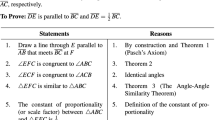Abstract
It is a plausible assumption that proof-novices try to make sense of the meaning of mathematical proof out of the perspective of every day thinking. In every day thinking, however, the domain of objects to which a general statement refers is not completely and definitely determined. Thus the very notion of a “universally valid statement” is not as obvious as it might seem. The phenomenon of a statement with an indefinite domain of reference can also be found in the history of mathematics when authors spoke of “theorems that admit exceptions”. Without having understood and accepted the theoretical nature of the idea of a universally valid statement the logical distinctions between, for example an implication and its converse loose their meaning for the learner. This might explain some disappointing findings of empirical research. Following a proposal by Inglis, Mejia–Ramos and Simpson it is suggested that in modelling mathematical thinking in proof situations the full scheme of Toulmin should be used including qualifications and rebuttals rather than a reduced version as is frequently done.







Similar content being viewed by others
References
Balacheff, N. (1988). Aspects of proof in pupils’ practice of school mathematics. In D. Pimm (Ed.), Mathematics, teachers and children (pp. 216–238). London: Hodder & Stoughton.
Durand-Guerrier, V. (2008). Truth versus validity in proving in mathematics. ZDM—The International Journal on Mathematics Education (this issue)
Fraser, C. (1987). Joseph Louis Lagrange’s algebraic vision of the calculus. Historia Mathematica, 14, 38–53.
Heath, T. L. (ed. and transl.) (1956). The thirteen books of Euclid’s elements: 2nd edn revised with additions. New York: Dover
Hoyles, C., & Küchemann, D. (2002). Students’ understanding of logical implication. EducationalStudies in Mathematics, 51(3), 193–223.
Inglis, M., Mejia-Ramos, J. P., & Simpson, A. (2007). Modelling mathematical argumentation: the importance of qualification. Educational Studies in Mathematics, 66, 3–21.
Jahnke, H. N. (1987). Motive und Probleme der Arithmetisierung der Mathematik in der ersten Hälfte des 19. Jahrhunderts—Cauchys Analysis in der Sicht des Mathematikers Martin Ohm. Archive for History of Exact Sciences, 37, 101–182.
Jahnke, H. N. (2003). Algebraic analysis in the 18th Century. In H. N. Jahnke (Ed.), A History of Analysis. American Mathematical Society & London Mathematical Society, 105–153
Jahnke, H. N.: (2005). A genetic approach to proof. In: Bosch, M. (ed.), Proceedings of the Fourth Congress of the European Society for Research in Mathematics Education, Sant Feliu de Guíxols, 428–437
Jahnke, H. N. (2007). Proofs and Hypotheses. ZDM—The International Journal on Mathematics Education, 39(1–2), 79–86.
Knorr, W. R. (1986). The ancient tradition of geometric problems. New York: Dover.
Küchemann, D. & Hoyles, C. (2005). Pupils’ awareness of structure on two number/algebra questions. In M. Bosch (Ed.), Proceedings of the Fourth Congress of the European Society for Research in Mathematics Education, Sant Feliu de Guíxols (pp. 438–447)
Lagrange, J. L. (1797). Théorie des fonctions analytiques. Paris: Imprimerie de la République.
Newton, I. (1669). De analysi per aequationes numero terminorum infinitas. Quoted according to the English translation in D. T. Whiteside (Ed.), The mathematical papers of Isaac Newton, Cambridge, Vol. II (pp. 206–247)
Ohm, M. (1823) Aufsätze aus dem Gebiete der höhern Mathematik. Berlin
Pedemonte, B. (2008). Argumentation and Algebraic Proof. ZDM—The International Journal on Mathematics Education (this issue)
Sørensen, H. K. (2005). Exceptions and counterexamples: Understanding Abel’s comment on Cauchy’s Theorem. Historia Mathematica, 32, 453–480.
Toulmin, S. (1974). The uses of argument. UK: Cambridge University Press, Paperback edition.
Author information
Authors and Affiliations
Corresponding author
Rights and permissions
About this article
Cite this article
Jahnke, H.N. Theorems that admit exceptions, including a remark on Toulmin. ZDM Mathematics Education 40, 363–371 (2008). https://doi.org/10.1007/s11858-008-0097-9
Accepted:
Published:
Issue Date:
DOI: https://doi.org/10.1007/s11858-008-0097-9




